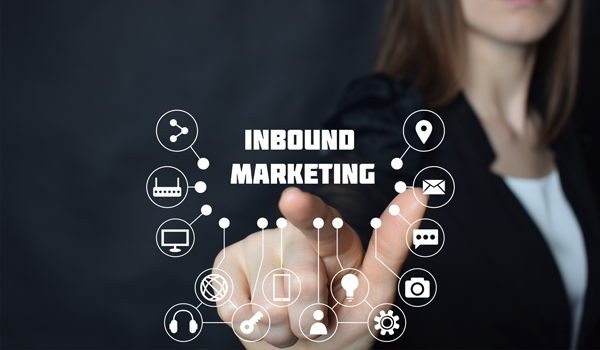With inbound marketing, you expand your company's online presence on Google and social media platforms. You are present everywhere customers are searching for your content and support. You leverage your strong web presence to connect with prospects, strategically drive customer acquisition, generate better and more leads for your sales team, and thus position marketing as a valued partner to sales on an equal footing. At the same time, you improve the efficiency of your marketing efforts.
Inbound marketing operates largely without advertising expenses and delivers greater impact and profitability for your business. Moreover, inbound provides an unbeatable customer experience by delivering measurable value with every interaction with prospects and customers. This excites customers and turns them into enthusiastic brand advocates.
1. Higher Visibility on the Internet
Customers search the internet for valuable and trust-building information. With inbound marketing, you provide customers with exactly the relevant and tailored content they are looking for. You offer this content precisely where potential customers seek it—on Google, on websites, in blogs, in online media, on social media, and through search engine advertising like Google AdWords.
With inbound marketing, you optimize your content for the specific keywords or SEO terms that both your potential customers and search engines are interested in. As internet users increasingly find, read, and share your content on social media, Google picks up these positive user signals and rewards you with a better ranking of your website in search results.
With inbound marketing, you are thus discovered by both people and Google. This effectively increases the visibility of your content and website on the internet.
2. Stronger Presence on Social Media
Through increased visibility on the web, your so-called Social Proof or "authority on social media" also rises. This makes your product and brand appear more attractive to people who have not yet noticed you.
Your status on social networks like Facebook, Twitter, and LinkedIn has a significant impact on your attractiveness to potential customers. When you actively and visibly engage in social network discussions with your brand, offer valuable content, and gather more followers, you become increasingly attractive to additional followers who might initially follow you simply because other well-known social media figures are already following you. This social network effect is described as Social Proof.
With Inbound Marketing, you consistently utilize all opportunities to be heard, seen, and presented on social networks. This significantly enhances your Social Proof and strengthens the performance of your social media and content activities.
3. Powerful Marketing Campaigns
With inbound marketing, you can quickly and effectively create targeted marketing campaigns for potential customers. You leverage the combined power of blogging, SEO, social media, keyword advertising, websites, content marketing, email marketing, and CRM all at once. Each of these tools is effective on its own, but their integration through inbound marketing is simply unbeatable.
Moreover, if you also run traditional outbound campaigns (TV, print, radio, direct mail), inbound marketing can significantly enhance the impact of these campaigns. For example, your commercials might direct viewers to a specific landing page on your website where potential customers can download highly valuable content in exchange for their contact information.
In any case, combining outbound campaigns with professional inbound marketing is more effective for customer acquisition than advertising, direct mail, or social media alone.
4. Enthralling Customer Experience
With Inbound Marketing, you centrally manage all customer interactions on the web and social media. You design personalized experiences and communications that perfectly align with each prospect and their stage in the buying process. Inbound Marketing focuses on a customer-centric approach to provide each prospect with the best possible buying experience and support them throughout the entire purchasing journey. The customer feels valued and sees that they are at the center of the buying process. This positions you as a trusted partner and creates a customer experience that delights even before the purchase.
In this way, Inbound Marketing creates significant value before the purchase that other companies may not be able to offer.
5. Marketing in Realtime
Conventional marketing campaigns often involve long planning and production times, which can last up to six months for a TV campaign, for example.
Inbound marketing significantly accelerates your campaign management and enables the creation of quickly executable marketing campaigns online.
With inbound, you receive insights and feedback on the potential and problems of your marketing activities much faster than before. You can optimize your marketing campaigns much more quickly—sometimes even in real time.
An inbound campaign is then adjusted step by step, and you monitor the success of each optimization live. Long preparation times for conventional marketing campaigns can be particularly risky when competitors have already switched to inbound marketing. In such cases, it’s often challenging to get your own messages through or to avoid ending up on the lower ranks of search engines like Google.
6. More Effective Support for Your Sales Team
Inbound Marketing is not only an effective marketing method but can also become the backbone of your sales efforts—providing more leads and revenue with less effort.
With Inbound Marketing, you can significantly reduce your sales costs. According to a study by software provider HubSpot, the cost per new sales contact can be reduced by up to 62% compared to traditional marketing methods (HubSpot, "State of Inbound," 2012). This way, Inbound Marketing provides crucial support to the sales team in achieving their goals and optimizing results. This marketing support is becoming increasingly important for sales in the digital era, as personal outreach by sales teams is increasingly deferred in the purchasing decision process, with people preferring to self-educate online. These are individuals that your sales team in the digital age can no longer reach effectively on their own.
Inbound Marketing helps you reach these potential customers early in their buying journey, thereby preparing the ground for your sales colleagues.
7. More Leads and Sales
Lead generation existed before Inbound Marketing, but with Inbound, it gets a digital boost. Through integrated email marketing, social media, webinars, and personalized consultations, the Inbound Marketing team builds an ongoing dialogue with many potential customers throughout their buying process (Lead Nurturing). Inbound Marketing creates new customer value with each of these interactions through content and advisory offers. This often results in generating many more leads for the sales team than would be possible without Inbound Marketing.
Marketing systematically qualifies the customer's problem-solving needs and analyzes how well the company's offering matches the individual's needs. Only when the lead's need has been thoroughly assessed and their readiness to purchase has visibly increased does Marketing pass the lead to Sales as a Sales Qualified Lead. Therefore, your sales team receives only high-quality leads from Marketing, i.e., those with a verifiable interest in your company's product solutions.
Before the first contact with the lead, the salesperson receives a well-maintained prospect dossier and can address any remaining purchase barriers during the personal conversation. This makes the sales process much more effective than before. Qualified prospects are simply easier to convert into customers than cold contacts.
With Inbound Marketing, your sales closing rate increases, creating many new success stories for your company's sales team.
8. Successful Customer Acquisition
With Inbound Marketing, you activate customer touchpoints that your company may not have systematically used for acquiring new customers before.
In Inbound Marketing, for example, you use social media intensively to generate traffic for your website. Your social posts regularly refer to new content on your site. Thus, you use social media not only to maintain a presence on the platform but primarily to direct the newly acquired contacts away from social media and towards your own website.
In Inbound Marketing, you systematically align all communication channels towards customer acquisition and contact generation. You do this not aggressively but by regularly offering useful and helpful information or services, which incentivize visitors to register on your website.
Customer acquisition through Inbound always starts with the thematic interest of your customers. This is the ideal foundation for eventually discussing your offers. Inbound is intelligent customer acquisition that begins with a potential customer's initial interest.
Inbound is becoming increasingly important for customer acquisition because buyers are less responsive to conventional advertising, as they use outbound channels like TV or magazines less intensively.
Today, the primary target groups aged 14 to 49 use the internet significantly more than television. Inbound Marketing is excellently suited to this media usage trend. Therefore, Inbound is also the ideal marketing concept for engaging with the young millennial target audience.
9. Alignment of Marketing and Sales
A marketing department that generates many new and qualified leads with inbound becomes a strong and valued partner for the sales team. Inbound creates a new team spirit between the two areas.
The goals and cultures of marketing and sales, which have traditionally been quite distant in some areas, align more closely through inbound (Marketing & Sales Alignment). Marketing and sales set shared success metrics, coordination processes, and responsibilities for lead generation, for building qualified and sales-ready leads (Lead Nurturing), and for the conversion process from leads to customers.
By connecting inbound marketing software with the CRM software of a sales team, you also create shared data transparency and real-time reporting that never existed before. With the implementation of inbound, both marketing and sales become more successful simultaneously. Companies with strong alignment between sales and marketing can grow faster.
10. High Return on Marketing Investment
Inbound makes the contribution of marketing to company success directly measurable for the first time in many businesses. Every standard inbound marketing software shows you how successful your individual marketing activities are and how you can further increase your success. You manage your marketing campaigns from a central online dashboard, utilizing professional marketing analytics to view your current marketing Return on Investment (ROI) in terms of newly acquired leads and customers, with their projected revenues or even the expected revenue over the customer relationship duration (Customer Lifetime Value).
If your marketing has previously only used outbound campaigns, adding inbound marketing will improve the ROI of your entire marketing budget, as you can now use every outbound contact to engage and guide prospects through the buying decision process with inbound strategies.
Ultimately, the cost of your marketing also affects the Return on Marketing Investment. Inbound marketing generates manageable costs for personnel, software, and agency support, even in smaller marketing teams. These costs are often significantly lower than the expenses associated with traditional outbound marketing, such as TV/print productions and conventional media planning.
Therefore, with inbound marketing, you may achieve much greater impact and visibility for your marketing campaigns—while keeping your marketing budget constant.


